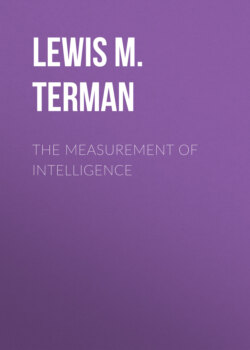Читать книгу The Measurement of Intelligence - Lewis M. Terman - Страница 21
На сайте Литреса книга снята с продажи.
Binet’s questionnaire on teachers’ methods of judging intelligence.[8]
ОглавлениеTable of Contents
Aroused by the skepticism so often shown toward his test method, Binet decided to make a little study of the methods by which teachers are accustomed to arrive at a judgment as to a child’s intelligence. Accordingly, through the coöperation of the director of elementary education in Paris, he secured answers from a number of teachers to the following questions:—
1 By what means do you judge the intelligence of your pupils?
2 How often have you been deceived in your judgments?
About 40 replies were received. Most of the answers to the first question were vague, one-sided, “verbal,” or bookish. Only a few showed much psychological discrimination as to what intelligence is and what its symptoms are. There was a very general tendency to judge intelligence by success in one or more of the school studies. Some thought that ability to master arithmetic was a sure criterion. Others were influenced almost entirely by the pupil’s ability to read. One teacher said that the child who can “read so expressively as to make you feel the punctuation” is certainly intelligent, an observation which is rather good, as far as it goes. A few judged intelligence by the pupil’s knowledge of such subjects as history and geography, which, as Binet points out, is to confound intelligence with the ability to memorize. “Memory,” says Binet, is a “great simulator of intelligence.” It is a wise teacher who is not deceived by it. Only a small minority mentioned resourcefulness in play, capacity to adjust to practical situations, or any other out-of-school criteria.
Some suggested asking the pupil such questions as the following:—
“Why do you love your parents?” “If it takes three persons seven hours to do a piece of work, would it take seven persons any longer?” “Which would you rather have, a fourth of a pie, or a half of a half?” “Which is heavier, a pound of feathers or a pound of lead?” “If you had twenty cents what would you do with it?”
A great many based their judgment mainly on the general appearance of the face and eyes. An “active” or “passive” expression of the eyes was looked upon as especially significant. One teacher thought that a mere “glance of the eye” was sufficient to display the grade of intelligence. If the eyes are penetrating, reflective, or show curiosity, the child must be intelligent; if they are heavy and expressionless, he must be dull. The mobility of countenance came in for frequent mention, also the shape of the head.
No one will deny that intelligence displays itself to a greater or less extent in the features; but how, asks Binet, are we going to standardize a “glance of the eye” or an “expression of curiosity” so that it will serve as an exact measure of intelligence?
The fact is, the more one sees of feeble-minded children, the less reliance one comes to place upon facial expression as a sign of intelligence. Some children who are only slightly backward have the general appearance of low-grade imbeciles. On the other hand, not a few who are distinctly feeble-minded are pretty and attractive. With many such children a ready smile takes the place of comprehension. If the smile is rather sweet and sympathetic, as is often the case, the observer is almost sure to be deceived.
As regards the shape of the head, peculiar conformation of the ears, and other “stigmata,” science long ago demonstrated that these are ordinarily of little or no significance.
In reply to the second question, some teachers stated that they never made a mistake, while others admitted failure in one case out of three. Still others said, “Once in ten years,” “once in twenty years,” “once in a thousand times,” etc.
As Binet remarks, the answers to this question are not very enlightening. In the first place, the teacher as a rule loses sight of the pupil when he has passed from her care, and seldom has opportunity of finding out whether his later success belies her judgment or confirms it. Errors go undiscovered for the simple reason that there is no opportunity to check them up. In the second place, her estimate is so rough that an error must be very great in order to have any meaning. If I say that a man is six feet and two inches tall, it is easy enough to apply a measuring stick and prove the correctness or incorrectness of my assertion. But if I say simply that the man is “rather tall,” or “very tall,” the error must be very extreme before we can expose it, particularly since the estimate can itself be checked up only by observation and not by controlled experiment.
The teachers’ answers seem to justify three conclusions:—
1. Teachers do not have a very definite idea of what constitutes intelligence. They tend to confuse it variously with capacity for memorizing, facility in reading, ability to master arithmetic, etc. On the whole, their standard is too academic. They fail to appreciate the one-sidedness of the school’s demands upon intelligence.
In a quaintly humorous passage discussing this tendency, Binet characterizes the child in a class as dénaturé, a French word which we may translate (though rather too literally) as “denatured.” Too often this “denatured” child of the classroom is the only child the teacher knows.
2. In judging intelligence teachers are too easily deceived by a sprightly attitude, a sympathetic expression, a glance of the eye, or a chance “bump” on the head.
3. Although a few teachers seem to realize the many possibilities of error, the majority show rather undue confidence in the accuracy of their judgment.
